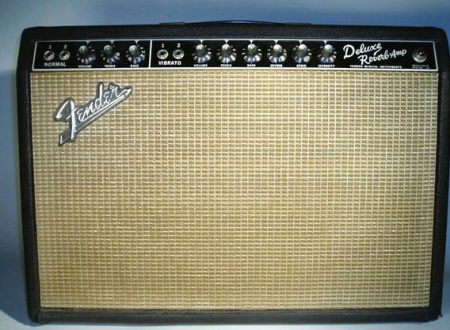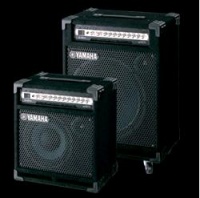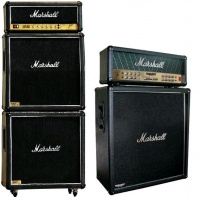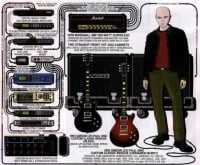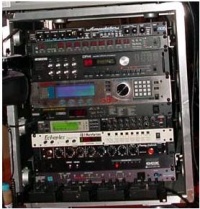Amplifier
Contents |
General Information
A guitar amplifier is an electronic machine to enforce the sound of a guitar or an eguitar. In case of an eguitar the amplifier is not wanted to simply make the eguitar louder but to give the sound a certain touch actively. A lot of guitarists see their amplifiers as a part of their instrument and use them, not to make the guitar sound louder, but to achieve a special expression with their amps. The signal of the pick up (you need at least one cogently) is transmitted via a cable or a wireless radio system. You can classify the amps by:
the way it's built (open or closed, combo, racksystem, head and speaker seceded)
the way of use (accoustic guitar, electric guitar, bassguitar, stage-, studio- or practice amp)
the used technique to get an amplification (tube, transistor, both („hybrid“) or modelling).
The way the amp sounds (clean – distortion; „brithish“ – „american“)
If you buy an amp, he will combine a lot of these cateogories, but with focus on one or another point.
History
Amplifiers came up in the 1930s when the power supply got started: As long as you could only use battery, you couldn't use amplifiers correctly. First the guitarists tried to amplify their accustic guitars to be able to play in front of a larger audience. Installing pick ups in the guitars was done fastly. But as there were big problems through the swinging body of the guitar (back coupling) something had to be changed. In 1941 Lester William Polfus (better known as Les Pauls) cut a guitar into two pieces and put a wood into the corpus. The eguitar was born. Soon the players started to experiment with the overdrive. At first the effect wasn't wanted but there were guitarists that liked that new sound – and – the audience, too.
This was the first step to the revolution of the amps and the eguitar. From the aim to make an accoustic guitar louder, it changed to create fuzzy new sounds with a lot of distortion.
The way an Amplifier works
An Amplifier has always certain elements your guitar signal needs to pass until you hear anything. So all the signals you output with your guitar run througg
...The entrance (connects the guitar with the amp, in general through a 6,35mm jack plug)
...The preamp section that regulates Gain (Volume) and the Equalizer
...The power amplifier that regulates the Master Volume
...The Speaker System
...The Power supply
Now you can hear the sound of your amplifier. In an amp you have 1-8 speakers with a magnitude of usually 8“ to 15“. For example a standard Marshall box has 4x12“ speaker, that lasts betweeen 100 and 400 RMS. Guitar amps have a power between 2 (Roland Microcube) and over 350W (Marshall Mode Four). Even more output power wouldn't be useful because on bigger gigs the instruments get amplified through the sound system / public adress system.
Non-linear Distortion
Now how get you your heavy metal crunch sound? This is made with non-linear overmodulation of you tone. If that happens in the preamp section it's called „Distortion“, in the power amp section „Overdrive“. As every guitarist should know, this can happen together, or – for even more distortion – in front of the amp with an distortion pedal. If you use the preamp distortion, the soundsignal is compressed more (common in Heavy Metal), if you use the poweramp overdrive, it's compressed less, you keep more dynamic (common in Blues / Rock).
In the dark days of the beginning of the eguitar, you simply could pull the volume up and you got a nice little distortion (as well poweramp section as preamp section, if both give 100% power). But you want your killer lead tone without your neighbours killing you or getting deaf. This works by installing a resistance coil in front of you amp that transforms the large part of your signal into heat, and gives the amp only a tiny part of the signal („Power-soak“). This little signal the amp amplifies to 100% and here comes => a quiet sound, like your amp would be as loud he could. Another methode to get to distortion is to buy a poweramp, run it on full power and a small speaker. But you have to be aware of the fact, that if you have only the signalmodulation of the preamp and play very low volume with the speakers, you get no poweramp distortion. So the first method is definatly the better one.
Little Lexicon on amp types
=== Combo Amp ===In this kind of amp you have Speaker, preamp and poweramp in one case, with the back open or closed what affects also on the sound.
Pros:
If the como's small you can transport it all in one
They need not much space
Smaller variations can be played easily with headphones or with batteries if you have no power supply.
Cons:
If you don't like the poweramp anymore, you can't keep the speakers(s) and buy another (better) poweramp, or backwards.
If you have a bigger combo (f.e. 100Watt) they're bulky, because you have to transport it all in one.
If the speaker and the preamp are apart you haven't a combo you have a speaker („box“ / „cabinet“) together with the poweramp („head“). If you put them on top of each other you have a „Stack“. If you have one head on top of one cabinet you have a „half stack“, if you have one head on top of two cabinets you have a „full stack“. A cabinet is usual a 4x12“ speaker. But there are cabinets ones with 4x10“, 1x12“ or 2x12“ speakers.
Rack
To explain you what a rack is, I have to tell you a little story: In a studio you record the guitar „dry“ that means, without effects only guitar => amp => speakers, and afterwards you add the effects. They came usuall from a 19“ „rack“ (Rack is only the word for a 19“ standardized holder that kept the effect-modules) and they were very good. As the guitarists wanted this kind of sound live on stage, they built theirselves a „rack“ that means, the signal live comes „dry“ (without effects) from an amp (combo or stack) over a microfone to a 19“-effect board (rack!) and the effects were mixed by. The „finished“ sound („wet“) was now transmitted to the sound system. In today's guitar language a „rack“ means a combination of an „normal“ amp with a 19“ effect board and another speaker(s) (sound system).
Pros:
High quality sound
very variable
Cons:
very expensive
need a lot of space
Tube amp
A tube amp amplifies the sound via electron tubes, which aren't used anymore in todays industry (because of weight, magnitude, building of warmth, power-vastagae, short live). But in guitar amps they are used because they have a very warm and full of pression sounding. The sound of tube amps is described as thick, loud, rough and warm in comparison to tube or modelling amps. Whether it's true or only a guitarist phantasm. You have to decide yourself.
Pros:
the sound*
style and accepatation under musicans ;)
A tube amp is subjective twice as loud as an tube / hybrid or modelling amp with same power
Cons:
the price
if used intensively, all 1-2years you have to change the tubes
they are very weighty
Transistor amps
Transistor amps are amps that use no electron tubes but transitor cicruit to amplify the incoming signal. It's said that they have a worse sound than tube amps, but than can't be said generally. Besides that they are cheaper and lighter than tube amps. They have still a bad repuation because in the early times of transitor amps, the technique wasn't matured and some bad products popped out.
Pros:
Cheaper than tube amps
They need no maintenance
Lighter than tube amps
Cons:
The sound*
They still have a bad reputation
Hybrid amps
Not much to say here. They combine the both techniques of transistor and tube amps, as they use tubes in the preamp and transistor circuits in the poweramp. They have a sound that comes closer to the tube amp than the transistor amps but in Germany ther's a saying „Nichts ganzes und nichs halbes“ that means that this kind of amps has neither the pure advantages of the tube amp, nor the pure advantages of the transistor amp, but it combines the disadvantages.
Pros:
Price
Versability
Cons:
sound*
Modelling amps
In the last 10 years a completely new concept of amps arrived: the modelling amp, it modyfies and amplifies the soundsignal by algorythms 100% mathematically and without any „real“ tube or stuff like that. The first product was from the Roland family, but popular the modellings became through the label „Line 6“ and their PODs. Still some musicans don't like modelling amps because they aren't exactly as good as the amps they copy. But in my opinion this is the technique of the future because with more and more CPU power and development they'll be able to immitate the sounds more and more close.
Pros:
Huge versability of sound
Cheap price for tons of effects and sounds
weight
Cons:
Some musicans call them inferior than normal amps because of the „steril“ sound*
You get „Mass instead of Class“
- But keep that in mind for all amp types: Sound is a matter of taste!!!
Famous amp manufactures & guitarits / bands who use that brand
(continue the list if something is missing;) )
- Ampeg (amplified peg) – Josh Homme
- Behringer -
- ENGL – Ritchie Blackmoore, Rammstein, Steve Morse, Deep Purple, Hammerfall
- Fender – a lot, f.e. Mark Knopfler
- Hughes & Kettner – Thommy Thater (KISS)
- Ibanez -
- Laney – Paul Gilbert
- Line 6 – James Hetfield
- Marshall – Jimmy Hendrix
- Mesa / Boogie – Kevin Wasserman (Offspring), Court Coubain
- Orange – AC/DC, Aerosmith, Led Zepplin, Pink Floys, Oasis, Black Sabbath
- Peavey – Björn Gelotte (In FlameS), Mike Kroeger (Nicklback), Eddie van Halen
- Roland
- Vox – Bryan May, Paul Weller
- Yamaha -



